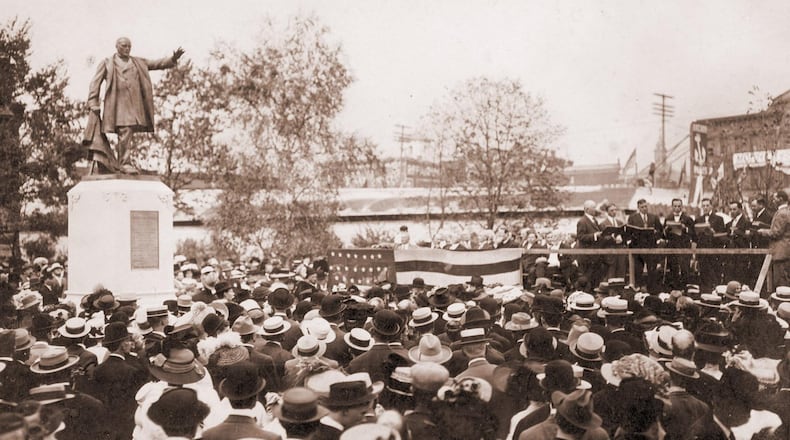He was assassinated during his second term as president in 1901. Dayton leaders considered him a beloved figure in Ohio and wanted to honor his memory with a statue, which continues to stand at the Dayton Metro Library’s main branch.
Monument funding
A fundraising effort was started for a monument in McKinley’s memory.
The fund received several thousand contributions of small amounts from children attending public schools, along with funds raised by other citizens. The cost of the monument was $6,000. The granite base was provided by city council.
The design was done by August Lukeman of New York, and it was cast in the foundry of John Williams in New York.
The statue is eight feet, four inches high, and 18 feet on its base. The figure is actually a copy of the McKinley statue which still stands today in North Adams, Massachusetts.
Credit: Lisa Powell
Credit: Lisa Powell
McKinley is wearing a suit and long overcoat, with his right hand resting on an American flag draped over banded arrows.
A plaque on the monument reads: “This monument is a tribute by the citizens of Dayton and the children of its schools.”
A sealed copper box, about two feet square, containing the names of all contributors, together with other historical data, was placed at the center of the concrete base of the memorial.
Dedication ceremony
A dedication ceremony was held on Sept. 17, 1910 in Cooper Park. It was attended by hundreds of spectators.
Along with singing performances, there were three main speakers: Rev. M.B. Fuller, pastor of Grace Methodist church; John Kirby Jr., the head of the monument committee; and Mayor Edward Burkhart.
Fuller addressed the crowd on the subject of “The Lessons of a Life and its Legacy to the American People,” according to a Dayton Daily News report at the time.
Here are some excerpts from his speech.
• “We submit the name of William McKinley as an illustrious example of a radiant consecrated personality whose life is worthy the emulation of the American people.”
• “He served well the state. He entered the service as a private and was repeatedly promoted for bravery. He was pre-eminently a man of peace. He will be remembered as a champion of reciprocity.”
Credit: Ty Greenlees
Credit: Ty Greenlees
Kirby followed Fuller, here are some excerpts from his remarks.
“Nowhere was the news of the murder received with deeper sorrow or with greater reverence for the martyred president that here in Dayton,” he said.
“This magnificent statue will outlive all buildings and will attract public attention and admiration when the most carefully erected mausoleums are forgotten. It is always in the eye of the passing public, and is, therefore, a constant reminder to our youth of not only the possibilities of high accomplishment, but of the appreciation and affection of a grateful people for the deeds worthy of lasting recognition.”
Credit: Lisa Powell
Credit: Lisa Powell
Slight move
The statue originally stood in front of the public library, facing Third Street. The original bronze plaque was stolen and replaced by the Dayton Rotary Club.
In 1961 it was moved to its present location, behind the Dayton Metro Library. At that time, the letters in the copper box in the base were examined and then replaced.
About the Author


